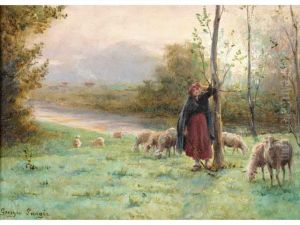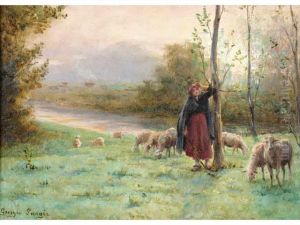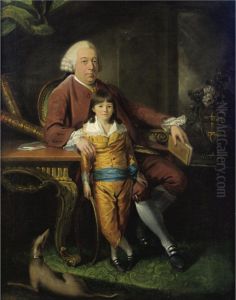George Francois Paul Laugee Paintings
George Francois Paul Laugee was a distinguished French painter and sculptor, known for his profound contributions to the world of fine arts during the late 19th and early 20th centuries. Born on January 21, 1853, in the commune of Montivilliers, in the Seine-Maritime department of Normandy, France, Laugee was destined to make a significant impact on the art scene of his time. His artistic journey began under the tutelage of his father, Désiré Laugée, who was also a respected artist, thereby embedding a deep appreciation and understanding of art in him from a very young age.
Laugee's education in art was furthered at the prestigious École des Beaux-Arts in Paris, where he studied under influential teachers such as Alexandre Cabanel and François Jouffroy. These experiences honed his skills and deeply influenced his artistic direction. Laugee's oeuvre is primarily known for its focus on rural scenes, peasant life, and the intimate relationship between man and nature, reflecting the Realist tradition. His paintings often depicted the hardworking peasants of France with a sense of dignity and grace, a theme that resonated with the societal and cultural shifts of his time.
Throughout his career, Laugee garnered significant recognition and was a regular participant in the Paris Salon, an annual exhibition by the French Academy of Fine Arts. His works were celebrated for their technical proficiency, emotional depth, and the artist’s ability to capture the essence of rural life. One of his most notable works, 'Pain', exhibited at the Salon of 1883, epitomizes his style and thematic focus, receiving widespread acclaim for its portrayal of the hardships and resilience of peasant life.
In addition to his painting, Laugee also explored sculpture, further showcasing his versatility as an artist. Despite the prominence of his thematic explorations of rural and peasant scenes, he was also adept at portraiture and historical subjects, demonstrating a broad range of skills and interests throughout his career.
George Francois Paul Laugee's legacy is one of profound empathy and respect for the rural working class, captured through his masterful paintings and sculptures. He passed away on March 5, 1937, leaving behind a body of work that continues to be celebrated for its contribution to the realism movement and its heartfelt portrayal of human dignity. His art remains a testament to the enduring spirit of the French peasantry, and his influence persists in the realms of French art and beyond.


